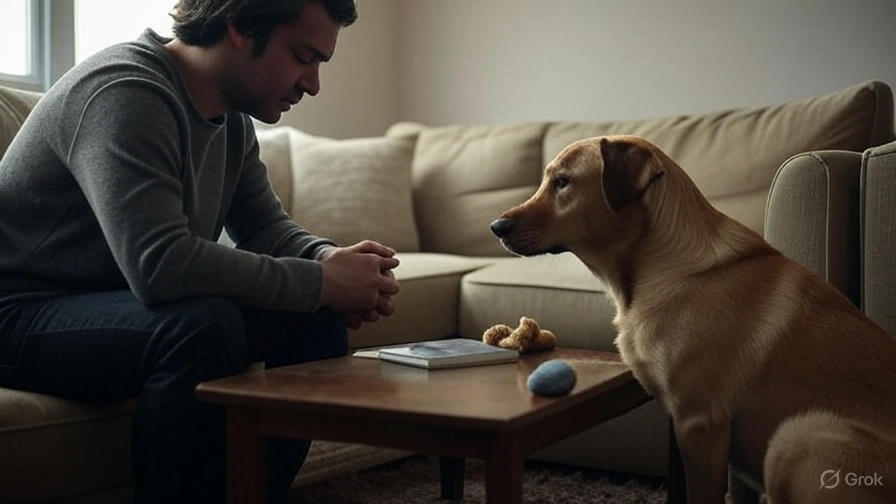How to Keep Your Dog Off the Couch?
Your favorite furry friend has claimed your couch as their personal throne. Sound familiar? You walk into the living room and find your dog sprawled across the cushions, looking completely at home. While this scene might seem adorable, many pet owners struggle with keeping dogs off furniture for various reasons.
Dogs naturally seek comfortable, elevated spots that smell like their favorite humans. Your couch provides the perfect combination of comfort, warmth, and your scent. However, you can successfully train your dog to stay off the furniture with the right approach and consistency.
Why Dogs Love Your Couch So Much
Dogs gravitate toward couches for several compelling reasons. First, these soft surfaces offer superior comfort compared to hard floors. Your dog experiences the same appreciation for cushioned surfaces that you do after a long day.
The elevation factor plays a significant role in your dog’s furniture preference. Couches provide an elevated vantage point that allows dogs to survey their territory while feeling secure. This instinctual behavior stems from their wild ancestors who sought high ground for safety and observation.
Your scent acts like a powerful magnet for your canine companion. Dogs possess an incredible sense of smell, and your couch holds concentrated traces of your personal scent. When you’re away, your dog finds comfort in being surrounded by familiar smells that remind them of you.
Temperature regulation also influences this behavior. Couches often sit in prime locations within your home, away from drafty areas and closer to heating sources. Your dog instinctively seeks these warmer spots, especially during colder months.
The Real Problems with Dogs on Furniture
Pet hair becomes a constant battle when dogs claim your couch as their territory. Even short-haired breeds shed continuously, leaving behind stubborn fur that embeds deep into fabric fibers. Regular vacuuming becomes a time-consuming chore that many pet owners find exhausting.
Hygiene concerns extend beyond visible dirt and hair. Dogs track outdoor contaminants like mud, pollen, and bacteria onto clean furniture surfaces. Their paws collect various substances during walks that transfer directly to your upholstery.
Behavioral issues often develop when dogs believe they own your furniture. Some dogs become possessive and may growl or snap when asked to move. This resource guarding behavior can escalate into more serious aggression problems if left unaddressed.
Furniture damage represents a costly consequence of allowing dogs on couches. Scratching, chewing, and general wear accelerate when dogs regularly use furniture. Replacing or repairing damaged upholstery involves significant expense that accumulates over time.
Training Methods That Work
Positive reinforcement forms the foundation of successful couch training. Reward your dog immediately when they choose their designated bed over the couch. Use high-value treats, enthusiastic praise, or brief play sessions to make staying off furniture more appealing than jumping on it.
Start training sessions when your dog is calm and receptive. Keep initial sessions short, around 5-10 minutes, to maintain your dog’s attention span. Gradually increase session length as your dog becomes more comfortable with the expectations.
The “off” command serves as your primary tool for furniture training. Begin by placing your dog on the couch, then clearly say “off” while gently guiding them down. The moment their paws touch the floor, immediately reward them with treats and praise.
Practice the “off” command multiple times daily until your dog responds consistently. Most dogs require 2-3 weeks of regular practice before reliably following this command. Patient repetition creates lasting behavioral changes that become second nature.
Consistency across all family members prevents confusion and accelerates training progress. Everyone in your household must enforce the same rules using identical commands and rewards. Mixed messages from different family members significantly slow down the training process.
Physical Barriers That Actually Work
Furniture covers designed specifically for pet deterrence provide immediate protection while training progresses. These covers feature textures that dogs find uncomfortable, such as plastic spikes or aluminum foil surfaces. The unpleasant sensation discourages dogs from jumping onto covered furniture.
Baby gates create physical boundaries that prevent access to entire rooms containing forbidden furniture. This method works particularly well when you cannot supervise your dog directly. Strategic gate placement allows you to control your dog’s movement throughout your home.
Motion-activated air sprayers deliver harmless but startling bursts of air when dogs approach furniture. These devices work independently of your presence, providing consistent deterrence even when you’re away from home. The unexpected sensation creates negative associations with approaching forbidden furniture.
Double-sided tape applied to furniture edges exploits most dogs’ dislike of sticky textures. The adhesive sensation on their paws creates an unpleasant experience that dogs quickly learn to avoid. This method requires regular tape replacement but offers an affordable deterrent option.
Creating Irresistible Alternatives
Your dog needs comfortable alternatives that compete with your couch’s appeal. Invest in high-quality dog beds that offer similar comfort levels to your furniture. Orthopedic foam beds provide excellent support for aging joints while remaining attractive to dogs of all ages.
Location dramatically affects your dog’s willingness to use their designated bed. Place dog beds in areas where your family spends significant time, such as near your couch or favorite chair. Dogs prefer sleeping close to their human companions rather than isolated in distant corners.
Elevated dog beds appeal to dogs who enjoy the height advantage that couches provide. These beds lift your dog off cold floors while satisfying their instinct to claim elevated territory. Many dogs readily accept elevated beds as suitable couch substitutes.
Make your dog’s sleeping area more appealing by adding items with your scent. Place an old shirt or pillowcase that smells like you near their bed. This familiar scent provides comfort and encourages your dog to spend time in their designated space.
Timing Your Training for Maximum Success
Early morning training sessions often produce the best results because dogs are naturally more alert and responsive after rest. Your dog’s energy levels are optimal for learning new behaviors during this time.
Avoid training immediately after meals when your dog may feel sluggish or distracted by digestion. Wait at least 30 minutes after feeding before beginning any training activities.
Training sessions should occur when your household is relatively calm. Avoid attempting furniture training during busy periods when distractions might interfere with your dog’s focus and learning ability.
End each training session on a positive note by ensuring your dog successfully completes at least one command before stopping. This positive ending reinforces good behavior and maintains your dog’s enthusiasm for future training sessions.

Common Training Mistakes to Avoid
Inconsistent enforcement represents the most frequent training error. Allowing your dog on the couch sometimes while forbidding it other times creates confusion that significantly delays progress. Your dog cannot understand arbitrary rule changes.
Physical punishment never effectively teaches desired behaviors and often creates fear-based responses. Pushing, yelling, or using spray bottles may temporarily stop the behavior but damages your relationship with your dog and can lead to anxiety or aggression.
Delayed corrections lose their effectiveness because dogs cannot connect the consequence to their action. Correct unwanted behavior immediately when you witness it, not minutes or hours later when the connection becomes unclear.
Insufficient positive reinforcement leaves dogs without clear guidance about desired behaviors. Many owners excel at correcting mistakes but forget to reward good choices. Balance corrections with generous praise for appropriate behavior.
Managing Multiple Dogs and Furniture Rules
Multiple dog households face unique challenges when implementing furniture restrictions. Dogs often follow pack behavior, meaning one dog’s rule-breaking can influence others to join in.
Train each dog individually before attempting group training sessions. Individual attention allows you to address each dog’s specific challenges and learning pace. Some dogs master new behaviors quickly while others require extended practice periods.
Use separate training areas when possible to prevent dogs from distracting each other during learning phases. Distracted dogs cannot focus on new commands and may develop incorrect associations.
Pack dynamics influence training success in multi-dog homes. Dominant dogs may claim furniture as territory and guard it from other dogs. Address these hierarchical issues separately from basic furniture training to prevent complications.
Long-term Maintenance and Success
Gradual reduction of rewards maintains trained behaviors over time. Start with frequent treats and praise, then slowly decrease the frequency while maintaining the behavior. This process, called intermittent reinforcement, actually strengthens learned behaviors.
Regular practice sessions, even after successful training, prevent regression. Schedule brief weekly refresher sessions to reinforce your dog’s furniture avoidance training. These maintenance sessions require minimal time but preserve months of training progress.
Life changes such as moving homes, adding new furniture, or schedule disruptions may require temporary training reinforcement. Dogs often test boundaries during transitions, so be prepared to resume more intensive training during adjustment periods.
Monitor your dog’s behavior for signs of regression such as approaching forbidden furniture or testing boundaries. Early intervention prevents full behavioral regression and requires less effort than restarting complete training programs.
Troubleshooting Persistent Problems
Some dogs display exceptional determination in claiming furniture despite consistent training efforts. These persistent cases often require specialized approaches tailored to individual personality traits and motivations.
Separation anxiety can drive furniture-seeking behavior when dogs desperately want to be close to their owner’s scent. Address underlying anxiety issues alongside furniture training for comprehensive behavioral improvement.
Older dogs with arthritis or joint pain may seek furniture for physical comfort rather than behavioral reasons. Consult your veterinarian about pain management options while providing orthopedic alternatives that address their physical needs.
Rescue dogs with unknown histories may have learned different household rules in previous homes. These dogs require patient, consistent training that rebuilds their understanding of appropriate household behavior.
Final Thoughts on Couch Training Success
Successfully keeping your dog off the couch requires patience, consistency, and understanding of your dog’s natural instincts. Most dogs can learn furniture boundaries within 2-6 weeks of dedicated training, though some may require longer depending on their age, personality, and previous experiences.
The investment in proper training pays dividends through cleaner furniture, better household hygiene, and improved human-canine relationships. Dogs thrive with clear boundaries and consistent expectations, often becoming more relaxed and confident when they understand household rules.
Remember that training represents an ongoing relationship between you and your dog rather than a one-time fix. Maintain your dog’s training through regular practice, positive reinforcement, and patience during occasional setbacks.
Your success depends on commitment to consistent application of these training principles. Dogs respond to clear communication, fair expectations, and generous rewards for appropriate behavior. With dedication and proper techniques, you can reclaim your couch while maintaining a loving relationship with your four-legged family member.







